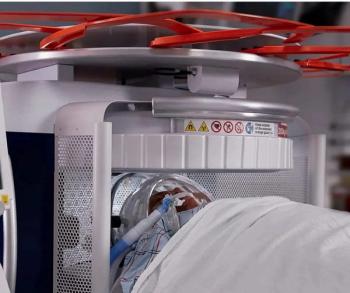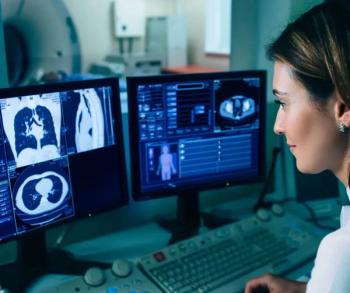
- Diagnostic Imaging Vol 32 No 4
- Volume 32
- Issue 4
Dose-saving technologies proliferate throughout CT
The means to reduce radiation dose are often at the fingertips of CT operators.
The means to reduce radiation dose are often at the fingertips of CT operators. Engineers have stuffed scanners full of dose-optimization technologies, available as factory presets and ready for use at the touch of a button. They are regularly updated, and in some cases complemented by advanced algorithms that chop dose by another 50% or more.
“There are a lot of tools they have-hardware, software, protocol-driven-that can be used to manage dose, and all of them are available without buying anything extra,” said Robb Young, acting director for the CT business unit of Toshiba America Medical Systems.
Presets onboard every major CT scanner made today automatically shape the CT beam to the patient, cut off extraneous radiation at the start and finish of scans, and process noise out of images, allowing end users to get good-quality images from less radiation. Software updates, such as Toshiba's version 4.5 for the Aquilion One, add new “reconstruction kernels” that remove more noise and further smooth images. The Toshiba update cuts dose by 21%, according to the company. Dose-reduction products, such as Siemens' X-Care, take charge of the x-ray beam itself, moderating its intensity when passing over sensitive body parts, such as the thyroid, lens of the eye, and female breast.
“We can reduce organ dose by up to 50%,” said Stefan Ulzheimer, Ph.D., director of global scientific marketing in Siemens' CT business unit.
Many of these capabilities go unused. To encourage their adoption, vendors are launching new training programs. Siemens is going so far as to look up customers' training accounts to identify those that have unused hours, then contacting them to offer dose-reduction training.
Some providers leverage this training to push dose down to the absolute minimum. Siemens will send field techs to work with individual customers to fine-tune protocols and cut dose until images are barely diagnostic.
“They are going out and sitting with customers at their scanners and figuring out the optimal balance between dose and image quality,” said André Hartung, Siemens vice president of CT marketing and sales.
These images are noisier and, therefore, nowhere near as pretty as the ones commonly produced, but patients make out by being exposed to less radiation.
“The industry 20 years ago was about making Rembrandt images,” said Steve Gray, GE vice president and CT business general manager. “We are now much more about making diagnostic images at the lowest possible dose.”
This takes some tinkering on the part of the providers, whether in collaboration with vendors or alone. To help the process along, some vendors, including Siemens and Toshiba, have come up with dose-reporting software that records and sends, to either a PACS or another information system, the two metrics, CTDI (computed tomography dose index) and DLP (CT dose index), that together define radiation dose.
The biggest gains in recent years have come from the use of iterative reconstruction algorithms. GE pioneered this dose-saving technology nearly two years ago with its ASIR (adaptive statistical iterative reconstruction). Siemens followed with its IRIS (iterative reconstruction in image space), which has gone through beta tests and is ready for rollout. Philips is testing beta versions of its iDose. And Toshiba is in the final stages of winning FDA clearance for its version of iterative reconstruction.
Usually only scanners with 256 or more slices have the inherent power necessary for iterative reconstruction. Upgrading 64-slice scanners with the power to run these algorithms requires a console swap. But for many it's well worth the cost, up to $200,000, and the day's downtime to install it, according to Gray.
“It can extend the life of the scanner another five years,” he said.
This form of dose reduction is too expensive for most 16-slice operations, but vendors are working on ways to get the price down. Siemens expects to have an offering for owners of 16-slice scanners by the end of this year. Others are working on their own solutions.
In the meantime, there are alternatives. Context-Vision has developed GOPView CT, image enhancement software that uses a proprietary and adaptive algorithm to cut dose. ContextVision is an OEM supplier, but its sister company, SharpView, sells a version of this software to end users as part of a “black box” that integrates computing hardware and algorithms compatible with installed scanners.
In the future, dose-reduction technologies now available as add-ons will be integral to the core design of CT scanners, according to Dominic Smith, Philips vice president of marketing and clinical science for CT.
“In the last decade CT has moved from the back room to the acute setting,” Smith said. “In the next decade, it will move into the chronic setting, monitoring disease over time. To make that change, you can't have a dose penalty.”
Articles in this issue
over 15 years ago
Philips' first quarter offers hope for better imaging marketplaceover 15 years ago
MR spectroscopy readies role as cancer diagnosis, treatment toolover 15 years ago
What's old is new again, and the world rolls onover 15 years ago
Three decades take MRI from cutting edge to sustainabilityover 15 years ago
Mobile image display pioneer blazes regulatory path at FDAover 15 years ago
CT found effective for Dx lung collapse in womenover 15 years ago
Abdominal plaque reveals coronary artery diseaseover 15 years ago
Modifying technique cuts radiation dose for CTAover 15 years ago
ACR launches breast MR accreditation programover 15 years ago
MR finds contralateral breast cancer in eldersNewsletter
Stay at the forefront of radiology with the Diagnostic Imaging newsletter, delivering the latest news, clinical insights, and imaging advancements for today’s radiologists.




























